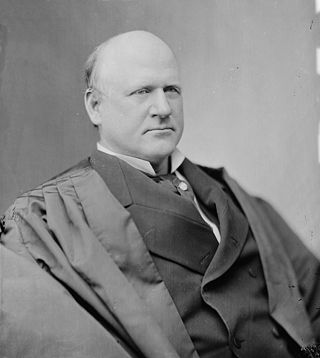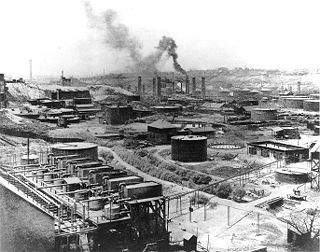
The Sherman Antitrust Act of 1890 is a United States antitrust law which prescribes the rule of free competition among those engaged in commerce. It was passed by Congress and is named for Senator John Sherman, its principal author.

The Clayton Antitrust Act of 1914, is a part of United States antitrust law with the goal of adding further substance to the U.S. antitrust law regime; the Clayton Act seeks to prevent anticompetitive practices in their incipiency. That regime started with the Sherman Antitrust Act of 1890, the first Federal law outlawing practices that were harmful to consumers. The Clayton Act specified particular prohibited conduct, the three-level enforcement scheme, the exemptions, and the remedial measures.

In the United States, antitrust law is a collection of mostly federal laws that regulate the conduct and organization of businesses to promote competition and prevent unjustified monopolies. The three main U.S. antitrust statutes are the Sherman Act of 1890, the Clayton Act of 1914, and the Federal Trade Commission Act of 1914. These acts serve three major functions. First, Section 1 of the Sherman Act prohibits price fixing and the operation of cartels, and prohibits other collusive practices that unreasonably restrain trade. Second, Section 7 of the Clayton Act restricts the mergers and acquisitions of organizations that may substantially lessen competition or tend to create a monopoly. Third, Section 2 of the Sherman Act prohibits monopolization.
Adair v. United States, 208 U.S. 161 (1908), was a US labor law case of the United States Supreme Court which declared that bans on "yellow-dog" contracts were unconstitutional. The decision reaffirmed the doctrine of freedom of contract which was first recognized by the Court in Allgeyer v. Louisiana (1897). For this reason, Adair is often seen as defining what has come to be known as the Lochner era, a period in American legal history in which the Supreme Court tended to invalidate legislation aimed at regulating business.
Pollock v. Farmers' Loan & Trust Company, 157 U.S. 429 (1895), affirmed on rehearing, 158 U.S. 601 (1895), was a landmark case of the Supreme Court of the United States. In a 5-4 decision, the Supreme Court struck down the income tax imposed by the Wilson–Gorman Tariff Act for being an unapportioned direct tax. The decision was superseded in 1913 by the Sixteenth Amendment to the United States Constitution, which allows Congress to levy income taxes without apportioning them among the states.

John Marshall Harlan was an American lawyer and politician who served as an associate justice of the U.S. Supreme Court from 1877 until his death in 1911. He is often called "The Great Dissenter" due to his many dissents in cases that restricted civil liberties, including the Civil Rights Cases, Plessy v. Ferguson, and Giles v. Harris. Many of Harlan's views expressed in his notable dissents would become the official view of the Supreme Court starting from the 1950s Warren Court and onward. His grandson John Marshall Harlan II was also a Supreme Court justice.

David Josiah Brewer was an American jurist who served as an associate justice of the Supreme Court of the United States from 1890 to 1910. An appointee of President Benjamin Harrison, he supported states' rights, opposed broad interpretations of Congress's power to regulate interstate commerce, and voted to strike down economic regulations that he felt infringed on the freedom of contract. He and Justice Rufus W. Peckham were the "intellectual leaders" of the Fuller Court, according to the legal academic Owen M. Fiss. Brewer has been viewed negatively by most scholars, though a few have argued that his reputation as a staunch conservative deserves to be reconsidered.
Standard Oil Co. of New Jersey v. United States, 221 U.S. 1 (1910), was a case in which the Supreme Court of the United States found Standard Oil Co. of New Jersey guilty of monopolizing the petroleum industry through a series of abusive and anticompetitive actions. The Court's remedy was to divide Standard Oil into several geographically separate and eventually competing firms.
Champion v. Ames, 188 U.S. 321 (1903), was a decision by the United States Supreme Court which held that trafficking lottery tickets constituted interstate commerce that could be regulated by the U.S. Congress under the Commerce Clause.
The McCarran–Ferguson Act, 15 U.S.C. §§ 1011-1015, is a United States federal law that exempts the business of insurance from most federal regulation, including federal antitrust laws to a limited extent. The 79th Congress passed the McCarran–Ferguson Act in 1945 after the Supreme Court ruled in United States v. South-Eastern Underwriters Association that the federal government could regulate insurance companies under the authority of the Commerce Clause in the U.S. Constitution and that the federal antitrust laws applied to the insurance industry.
Northern Securities Co. v. United States, 193 U.S. 197 (1904), was a case heard by the U.S. Supreme Court in 1903. The Court ruled 5-4 against the stockholders of the Great Northern and Northern Pacific railroad companies, which had essentially formed a monopoly and to dissolve the Northern Securities Company.
Toolson v. New York Yankees, 346 U.S. 356 (1953), is a United States Supreme Court case in which the Court upheld, 7–2, the antitrust exemption first granted to Major League Baseball (MLB) three decades earlier in Federal Baseball Club v. National League. It was also the first challenge to the reserve clause which prevented free agency, and one of the first cases heard and decided by the Warren Court.
Loewe v. Lawlor, 208 U.S. 274 (1908), also referred to as the Danbury Hatters' Case, is a United States Supreme Court case in United States labor law concerning the application of antitrust laws to labor unions. The Court's decision effectively outlawed the secondary boycott as a violation of the Sherman Antitrust Act, despite union arguments that their actions affected only intrastate commerce. It was also decided that individual unionists could be held personally liable for damages incurred by the activities of their union.
Swift & Co. v. United States, 196 U.S. 375 (1905), was a case in which the United States Supreme Court ruled that the Commerce Clause allowed the federal government to regulate monopolies if it has a direct effect on commerce. It marked the success of the Presidency of Theodore Roosevelt in destroying the "Beef Trust". This case established a "stream of commerce" argument that allows Congress to regulate things that fall into either category. In particular it allowed Congress to regulate the Chicago slaughterhouse industry. Even though the slaughterhouse supposedly dealt with only intrastate matters, the butchering of meat was merely a "station" along the way between cow and meat. Thus, as it was part of the greater meat industry that was between the several states, Congress can regulate it. The Court's decision halted price fixing by Swift & Company and its allies.

Melville Weston Fuller was an American politician, attorney, and jurist who served as the eighth chief justice of the United States from 1888 until his death in 1910. Staunch conservatism marked his tenure on the Supreme Court, exhibited by his tendency to support unfettered free enterprise and to oppose broad federal power. He wrote major opinions on the federal income tax, the Commerce Clause, and citizenship law, and he took part in important decisions about racial segregation and the liberty of contract. Those rulings often faced criticism in the decades during and after Fuller's tenure, and many were later overruled or abrogated. The legal academy has generally viewed Fuller negatively, although a revisionist minority has taken a more favorable view of his jurisprudence.
Pfizer Inc. v. Government of India, 434 U.S. 308 (1978), decision of the Supreme Court of the United States in which the Court held that foreign states are entitled to sue for treble damages in U.S. courts, and should be recognized as "persons" under the Clayton Act.

The history of United States antitrust law is generally taken to begin with the Sherman Antitrust Act 1890, although some form of policy to regulate competition in the market economy has existed throughout the common law's history. Although "trust" had a technical legal meaning, the word was commonly used to denote big business, especially a large, growing manufacturing conglomerate of the sort that suddenly emerged in great numbers in the 1880s and 1890s. The Interstate Commerce Act of 1887 began a shift towards federal rather than state regulation of big business. It was followed by the Sherman Antitrust Act of 1890, the Clayton Antitrust Act and the Federal Trade Commission Act of 1914, the Robinson-Patman Act of 1936, and the Celler-Kefauver Act of 1950.

The White Court refers to the Supreme Court of the United States from 1910 to 1921, when Edward Douglass White served as Chief Justice of the United States. White, an associate justice since 1894, succeeded Melville Fuller as Chief Justice after the latter's death, and White served as Chief Justice until his death a decade later. He was the first sitting associate justice to be elevated to chief justice in the Court's history. He was succeeded by former president William Howard Taft.

The Fuller Court refers to the Supreme Court of the United States from 1888 to 1910, when Melville Fuller served as the eighth Chief Justice of the United States. Fuller succeeded Morrison R. Waite as Chief Justice after the latter's death, and Fuller served as Chief Justice until his death, at which point Associate Justice Edward Douglass White was nominated and confirmed as Fuller's replacement.










